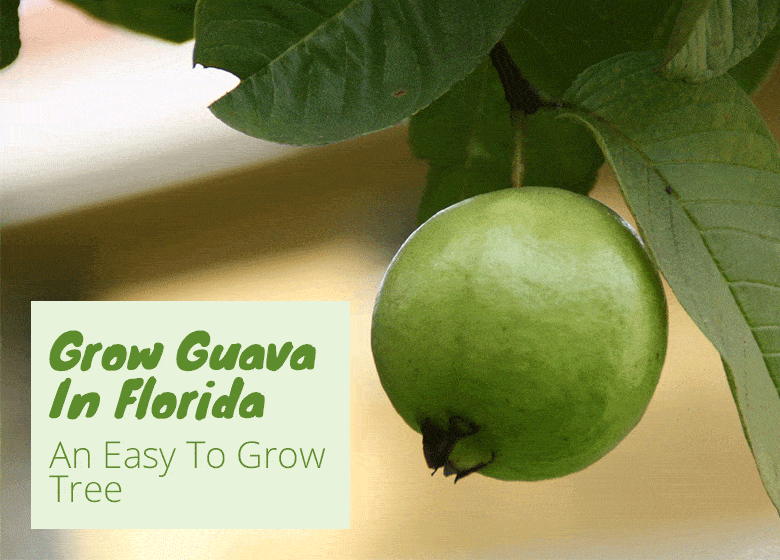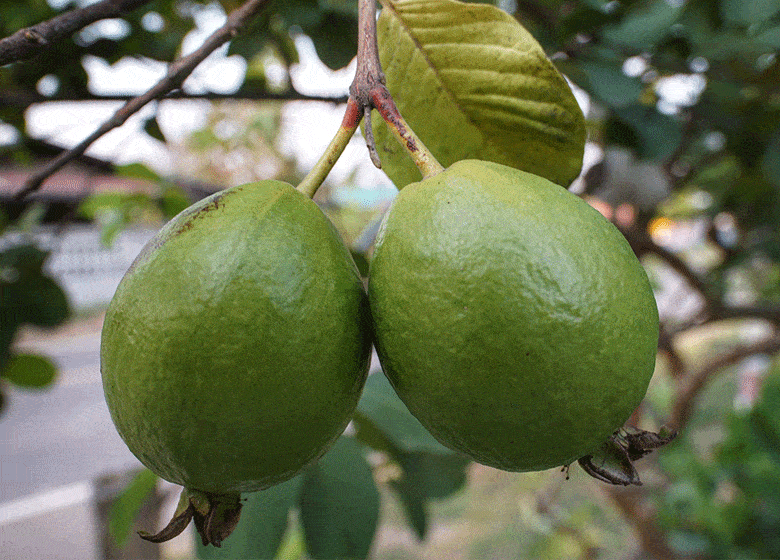
It’s easy to grow guava in Florida. In fact, it grows wild in some parts of the state.
The guava tree thrives in the warm climate of Florida and other US regions like Hawaii. It is adapted to both tropical and subtropical climatic conditions. The guava tree is indigenous to the Americas, and it was introduced to South Florida in the 1800s.
Guava plantations spread across the region, and commercial areas began to grow guava in Florida in the early 1990s. Areas like Punta Gorda and Opa Locka became important areas for guava production.
Best Time to Plant Guava in Florida
It is best to plant guava trees over Spring. The rain and the sun will encourage the growth of the tree during this period. It will also be easy to dig through the soil. Guava trees crave a lot of sunlight to grow.
| North Florida | Mar-Apr |
| Central Florida | Mar-Apr |
| South Florida | Feb-Apr |
Best Guava Varieties For Florida
Multiple varieties of Guava will grow in Florida.
Guava trees look similar based on outside appearance. The differences are more pronounced within the fruits they produce. The fruit’s flesh will range in color, from white to red. These varieties are discussed further below:
Red- and Pink-fleshed Types
The varieties in this category produce sweet and intensely flavored fruit. The “Red Indian” was first cultivated in Florida in 1946, and it has intensely sweet fruit. Its medium to large fruits are eaten fresh despite their seediness. The cultivars “Supreme” and “Ruby” from Florida were combined to make the “Ruby X.”
Another popular variety is “Homestead” guava, whose sweet fruit bears a deep salmon-pink hue. The “Uma” is known for its heavy yields, and it originated from San Diego, California.
White-Fleshed Types
White-fleshed guavas are characterized by mild and acidic fruits that lack fragrance. The skin remains green even when ripe, although some types will develop a pink blush. The fruit’s flesh will either be soft or crisp.
The fruits of the “Mexican Cream” has a sweet aroma and creamy flesh. Another variety with deliciously-fleshed fruits is the “Sweet White Indonesian.” The “White India” has tart and seedy fruits.
Yellow-Fleshed Types
The fruits of the “Detwiler” commonly reach three inches in diameter. The flesh can either be pink or yellowish, and it has a heavy flavor.
Growing Guava
The guava tree is quite self-sufficient once it becomes well-established.
The first step is to narrow down on a planting location. The trees thrive in areas where winters are cool, and summers are warm. Select a location with full sun away from structures like trees and buildings. The area should not be prone to flooding, and the plant does not do well during prolonged flooding.
Guava trees will grow in a variety of soil varieties, including loams, muck, and sand, provided there is good drainage. The ideal PH falls between 4.5 to 7.
Planting from Seeds
Guava can be grown in a greenhouse or indoor containers from seeds.
Extract several seeds from a guava fruit and clean them in water. If you intend to plant them after removal, you can boil them in a pot of water for five minutes to encourage quick germination. Alternatively, soak the seeds for two weeks before planting. Either method will bring the seed out of it’s dormancy period.
The germination medium can be made entirely of sand or a mix of sand and topsoil in equal parts. Place the seeds ¼-inch deep and 1 to 1 1/2 -inches apart.
A lot of water is needed to ensure the soil is moist. The seedlings will be ready to be transplanted into bigger containers once they develop a set of true leaves. When transplanting, remove the plant carefully with its roots and fill the individual containers with clay loam soil and compost. Choose an external spot that is under full sun and place the trees at least 33 ft apart.
Planting from Cuttings
Guava cuttings typically yield more fruit when compared to seeds. Dig a hole that is about 2 ft deep and loosen the soil at the bottom. It is not necessary to add compost, topsoil, or fertilizer to the hole. Fill the hole to around the length of your index finger to form a mound. The tree’s graft line should be above ground level, with the roots spread across the hole. Multiple trees should be 10 ft to 12 ft apart.
Watering
Water guava trees when planting and every day for one to two weeks. The trees will fair fine with being watered once or twice per week for the first several months. Ensure they are well-watered during prolonged dry seasons. The most important period to maintain an irrigation schedule is between bloom to fruit development.
Fertilization
Young trees demand fertilizers every one to two months in the first year. Fertilizer mixture should contain phosphoric acid (6-10%), nitrogen (6-10%), potash (6-10%), and magnesium (4-6%). For bearing trees, phosphoric acid should be decreased to 2-4%, and potash increased to 9-15%. The trees should receive yearly nutritional sprays of manganese, zinc, copper, and boron from Spring to Summer. To address iron deficiency in young guava trees, allocate iron chelates.

Harvesting Guava
The guava tree achieves maturity a few years after planting, with its major blooming in early Spring. The fruit will mature between 90 to 150 days after the tree blooms. The tree will typically bear fruit two to four years after propagation.
The fruit becomes soft and changes color when ripe. If you pluck the fruits when they are still green, place them in a cool area, and they may take between two to five weeks to ripen. For fruits that ripen on the trees, they should be eaten immediately since they are highly perishable. You can, however, wrap them in a plastic bag and place it in the refrigerator to extend their shelf life.
Pests or Problems with Guava
Fruit flies are common pests with the guava tree. The pest can be seen lying on the fruit, and after reproduction, the maggot bores through the skin to feed on the pulp. The infested fruit will rot and eventually fall down.
The bark eating caterpillar makes holes in the wood and bark and may cause branches to dry up. The guava shoot borer targets the tender shoots of nursery trees.
Guava wilt is the major disease affecting guava trees. It is caused by a fungus, which first targets the roots. The symptoms include yellowing of leaves, premature shedding, underdeveloped fruits, sparse foliage, and root rot.
Guava fruits are also prone to fungal attacks. The fruit rot takes place within two to three days.
Growing Guava In Florida
- Choose Florida friendly varieties like Red Indian, Homestead, and Mexican Cream.
- Plant in full sun and well-draining soil
- The best time to plant your guava tree in Florida is early spring. These are the months of March and April.
- If planting from seed you need to bring your seed out of dormancy. Planting a cutting will produce fruit much quicker than growing from seed.
- Water regularly when first getting established and while flowering and fruiting.
- Harvest after fruits change color and soften. It can be 90-150 days after flowering.
You Will Probably Also Like


